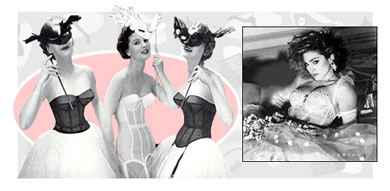Bustiers

Fashion Synopsis
It’s pronounced “BOOST-ee-yay,” but most men settle for a slack-jawed drool and a few garbled syllables. The bustier (French for “boost”) enhances a woman’s mammary assets by boosting them up with underwires, pads, and a network of stiff metal or plastic rods called boning. Usually strapless, the flattering shape of the undergarment simultaneously slims the waist while lifting the bosom, and if that isn’t a two-for-one deal, we don’t know what is. This breakthrough design flattened the flabby and lifted the low without the constrictive, life-endangering constraints of the corset.
In the late 1910's, women shed the body-altering corset and adopted the minor molding offered by girdle bustiers. The advanced technology of knit fabric allowed the wearer to breathe comfortably and the body to expand beneath the garment instead of being shaped into a hard casing of immovable metal and fabric. This new freedom allowed women to throw away their corsets, which quickly disappeared from the mainstream of undergarments.
Manufactured in industrial strength rubbers and nylons, these anti-corsets cinched in the waist and hips and ended just slightly below the buttocks to create a single smooth silhouette. The addition of ‘garters,’ or straps that held up silk nylon stockings and prevented them from sagging, made the bustier (also called a merry widow) a simple, all-in-one foundation garment that revolutionized women’s dressing.
As 1920's fashion became straight and shapeless, the bustier showed its alternative uses. Those naturally lean and long limbed were able to wear only cami-knickers or the popular tap pants and flat bra. But those who needed a little help embraced the girdle bustier, forgoing the “boosting” in exchange for a flattened, boyish chest.
A combination bra/corset, bustiers became absolutely necessary in the 40's and 50's when small cinched waists and strapless gowns were the rage. Small, waist-length bustiers lifted and shaped via spiral shaped ‘cones’ that created the bullet bra look much desired in the 50's. Wires and bones still marked the bustier’s form, but the advances in materials and construction techniques enhanced the comfort for the wearer. A small price to pay for such a lovely look.
The 60's put the bustier in the closet, as fashion favored another shapeless decade thanks to the boyish model Twiggy. With lean looks in, the bustier would be a little used fashion undergarment except for special occasions or under formal gowns. That is, until the 80’s…
In the ‘excess breeds success’ era, Madonna would bring underwear out from behind the confines of clothing to reveal the appeal of these sexy suits. Her “Like a Virgin” days paired up white lace bustiers with lace gloves and crinolines for a flirty mix of virgin and vixen, proving that too much lace is never enough. She exposed the understated sexiness of the bustier as casually worn with fitted capri pants, as well as the powers of its seduction when paired with gold tassels and fishnets. Even fashion designer Jean Paul Gaultier got into the act, modernizing Madonna’s memorable look with his extreme spiral stitched cone bustiers in sleek satins.
Bustiers and their companions, bra tops, became a fanciful part of 80's fashion. Lingerie sales skyrocketed, and underwear had its hottest outerwear breakout since the 1950’s, when the plain white t-shirt leapt out from underneath men’s dress shirts and was adopted by rebellious teenagers.
Now safely back in the bedroom, the bustier has returned to its understated glory. A lingerie staple, along with the miraculous Wonderbra and thong underwear, the bustier’s transforming abilities extend beyond the obvious. Never underestimate the powers that lie beneath the surface.
